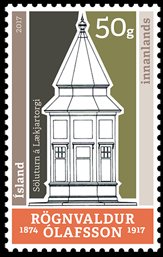Stamp: The First Icelandic Architect Rögnvaldur Ágúst Ólafsson (Iceland 2017)
The First Icelandic Architect Rögnvaldur Ágúst Ólafsson (Iceland 2017)
16 February (Iceland ) within release Architect goes into circulation Stamp The First Icelandic Architect Rögnvaldur Ágúst Ólafsson face value 195 Icelandic króna
| Stamp The First Icelandic Architect Rögnvaldur Ágúst Ólafsson in catalogues | |
|---|---|
| Michel: | Mi: IS 1517 |
| Stamp Number: | Sn: IS 1428 |
Stamp is vertical format.
nment Public Buildings in 1906. Although he only was able to continue his work for 12 years, he designed 30 churches, some 30 houses in the capital and dozens of other buildings across the country. He designed many of the most impressive wooden buildings that were built in the capital in the first decade of the 20th century. Rögnvaldur‘s design for many houses was influenced by the Swiss chalet style and neoclassical architecture. One of Rögnvaldurs best known works is the Húsavík Church, inaugurated in 1907. Among other works were Vífilsstaðir Hospital, built in 1908, and the Church of Þingeyrar, a stone building in the Gothic style. Rögnvaldur died of tuberculosis in Vífilsstaðir Hospital at the age of 42. A book by designer Björn G. Björnsson commemorating Rognvaldur Olafsson and his work was published in the end of 2016.Stamp The First Icelandic Architect Rögnvaldur Ágúst Ólafsson it reflects the thematic directions:
An architect is a person who plans, designs, and oversees the construction of buildings. To practice architecture means to provide services in connection with the design of buildings and the space within the site surrounding the buildings that have human occupancy or use as their principal purpose. Etymologically, the term architect derives from the Latin architectus, which derives from the Greek (arkhi-, chief + tekton, builder), i.e., chief builder
A building or edifice is a structure with a roof and walls standing more or less permanently in one place, such as a house or factory. Buildings come in a variety of sizes, shapes and functions, and have been adapted throughout history for a wide number of factors, from building materials available, to weather conditions, to land prices, ground conditions, specific uses and aesthetic reasons. Buildings serve several needs of society – primarily as shelter from weather, security, living space, privacy, to store belongings, and to comfortably live and work. A building as a shelter represents a physical division of the human habitat (a place of comfort and safety) and the outside (a place that at times may be harsh and harmful).
Famous People refers to the fame and public attention accorded by the mass media to individuals or groups or, occasionally, animals, but is usually applied to the persons or groups of people (celebrity couples, families, etc.) themselves who receive such a status of fame and attention. Celebrity status is often associated with wealth (commonly referred to as fame and fortune), while fame often provides opportunities to make money.
A man is an adult male human. Prior to adulthood, a male human is referred to as a boy (a male child or adolescent).




